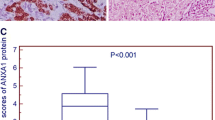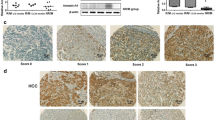Abstract
Hepatic annexin A2 (ANXA2) orchestrates multiple biologic processes and clinical symptoms and plays a key role in development, metastasis, and drug resistance of lethal hepatocellular carcinoma (HCC). However, the prognostic significance of ANXA2 for HCC has not been elucidated up to now. In this study, ANXA2 was frequently found to be up-regulated in HCC tissues compared with benign liver disease (BLD) tissues, which was consistent with the results in serum samples and tissue specimens of patients with HCC. Furthermore, ANXA2 expression was significantly correlated with differentiated degree, intrahepatic metastasis, portal vein thrombus, and tumor node metastasis (TNM) staging. More importantly, increased ANXA2 level was first confirmed to be closely associated with shortened overall survival of HCC (χ 2 = 12.872, P = 0.005) and identified as an independent prognostic factor (hazard ratio 1.338, 95 % confidence interval (CI) 1.013 ~ 1.766, P = 0.040), suggesting that ANXA2 up-regulation might represent an acquired metastasis phenotype of HCC, help to screen out high-risk population for HCC, or more effectively treat a subset of postsurgical HCC patients positive for ANXA2.



Similar content being viewed by others
Abbreviations
- HCC:
-
Hepatocellular carcinoma
- ANXA2:
-
Annexin A2
- BLD:
-
Benign liver diseases
- TMA:
-
Tissue microarray
- FFPE:
-
Formalin-fixed paraffin-embedded
- ELISA:
-
Enzyme-linked immunosorbent assay
- PBS:
-
Phosphate-buffered saline
- qRT-PCR:
-
Quantitative real-time polymerase chain reaction
- IHC:
-
Immunohistochemistry
- SD:
-
Standard deviation
- tPA:
-
Tissue plasminogen activator
- AFP:
-
Alpha-fetoprotein
References
Siegel R, Ma J, Zou Z, Jemal A. Cancer statistics, 2014. CA Cancer J Clin. 2014;64(1):9–29.
Nguyen VT, Law MG, Dore GJ. Hepatitis B-related hepatocellular carcinoma: epidemiological characteristics and disease burden. J Viral Hepat. 2009;16(7):453–63.
Ichikawa T, Sano K, Morisaka H. Diagnosis of pathologically early HCC with EOB-MRI: experiences and current consensus. Liver Cancer. 2014;3(2):97–107.
Shoreibah MG, Bloomer JR, McGuire BM, Massoud OI. Surveillance for hepatocellular carcinoma: evidence, guidelines and utilization. Am J Med Sci. 2014;347(5):415–9.
Sun H, Zhu MS, Wu WR, Shi XD, Xu LB. Role of anti-angiogenesis therapy in the management of hepatocellular carcinoma: the jury is still out. World J Hepatol. 2014;6(12):830–5.
Wang CY, Lin CF. Annexin A2: its molecular regulation and cellular expression in cancer development. Dis Markers. 2014;2014:308976.
Chaiteerakij R, Addissie BD and Roberts LR. Update on biomarkers of hepatocellular carcinoma. Clin Gastroenterol Hepatol. 2013.
Zhao YJ, Ju Q, Li GC. Tumor markers for hepatocellular carcinoma. Mol Clin Oncol. 2013;1(4):593–8.
Jour G, Gullet A, Liu M, Hoch BL. Prognostic relevance of Federation Nationale des Centres de Lutte Contre le Cancer grade and MDM2 amplification levels in dedifferentiated liposarcoma: a study of 50 cases. Mod Pathol. 2015;28(1):37–47.
Llovet JM, Bruix J. Prospective validation of the Cancer of the Liver Italian Program (CLIP) score: a new prognostic system for patients with cirrhosis and hepatocellular carcinoma. Hepatology. 2000;32(3):679–80.
Luo CH, Liu QQ, Zhang PF, Li MY, Chen ZC, Liu YF. Prognostic significance of annexin II expression in non-small cell lung cancer. Clin Transl Oncol. 2013;15(11):938–46.
Yang T, Peng H, Wang J, Yang J, Nice EC, Xie K, et al. Prognostic and diagnostic significance of annexin A2 in colorectal cancer. Colorectal Dis. 2013;15(7):e373–81.
Waisman DM. Annexin II, tetramer: structure and function. Mol Cell Biochem. 1995;149–150:301–22.
Hedhli N, Falcone DJ, Huang B, Cesarman-Maus G, Kraemer R, Zhai H, et al. The annexin A2/S100A10 system in health and disease: emerging paradigms. J Biomed Biotechnol. 2012;2012:406273.
Vedeler A, Hollas H, Grindheim AK, Raddum AM. Multiple roles of annexin A2 in post-transcriptional regulation of gene expression. Curr Protein Pept Sci. 2012;13(4):401–12.
Mohammad HS, Kurokohchi K, Yoneyama H, Tokuda M, Morishita A, Jian G, et al. Annexin A2 expression and phosphorylation are up-regulated in hepatocellular carcinoma. Int J Oncol. 2008;33(6):1157–63.
Gao PJ, Shi Y, Gao YH, Liu YW, Tan Y. The receptor for beta(2)GP I on membrane of hepatocellular carcinoma cell line SMMC-7721 is annexin II. World J Gastroenterol. 2007;13(24):3364–8.
Zhang HJ, Yao DF, Yao M, Huang H, Wu W, Yan MJ, et al. Expression characteristics and diagnostic value of annexin A2 in hepatocellular carcinoma. World J Gastroenterol. 2012;18(41):5897–904.
Sun Y, Gao G, Cai J, Wang Y, Qu X, He L, et al. Annexin A2 is a discriminative serological candidate in early hepatocellular carcinoma. Carcinogenesis. 2013;34(3):595–604.
Zhao P, Zhang W, Tang J, Ma XK, Dai JY, Li Y, et al. Annexin II promotes invasion and migration of human hepatocellular carcinoma cells in vitro via its interaction with HAb18G/CD147. Cancer Sci. 2010;101(2):387–95.
Zhang W, Zhao P, Xu XL, Cai L, Song ZS, Cao DY, et al. Annexin A2 promotes the migration and invasion of human hepatocellular carcinoma cells in vitro by regulating the shedding of CD147-harboring microvesicles from tumor cells. PLoS One. 2013;8(8), e67268.
Wang C, Guo Y, Wang J, Min Z. Annexin A2 knockdown inhibits hepatoma cell growth and sensitizes hepatoma cells to 5-fluorouracil by regulating betacatenin and cyclin D1 expression. Mol Med Rep. 2015;11(3):2147–52.
Ministry of Health of the People’s Republic of C. Updated standards for the diagnosis and treatment of primary liver cancer. Zhonghua Gan Zang Bing Za Zhi. 2012;20(6):419–26.
o Y. [Management of clinical diagnosis, and antiviral therapy for HBV-related cirrhosis]. Zhonghua Gan Zang Bing Za Zhi. 2014;22(5):327-335.
M PN. World Medical Association publishes the Revised Declaration of Helsinki. Natl Med J India. 2014;27(1):56.
Luo RZ, Cai PQ, Li M, Fu J, Zhang ZY, Chen JW, et al. Decreased expression of PTPN12 correlates with tumor recurrence and poor survival of patients with hepatocellular carcinoma. PLoS One. 2014;9(1), e85592.
Zhang HJ, Yao DF, Yao M, Huang H, Wang L, Yan MJ, et al. Annexin A2 silencing inhibits invasion, migration, and tumorigenic potential of hepatoma cells. World J Gastroenterol. 2013;19(24):3792–801.
Wang Q, Ni Q, Wang X, Zhu H, Wang Z, Huang J. High expression of RAB27A and TP53 in pancreatic cancer predicts poor survival. Med Oncol. 2015;32(1):372.
Breuhahn K, Schirmacher P. Reactivation of the insulin-like growth factor-II signaling pathway in human hepatocellular carcinoma. World J Gastroenterol. 2008;14(11):1690–8.
Kwon MJ, Shin YK. Epigenetic regulation of cancer-associated genes in ovarian cancer. Int J Mol Sci. 2011;12(2):983–1008.
Zhang X, Liu S, Guo C, Zong J, Sun MZ. The association of annexin A2 and cancers. Clin Transl Oncol. 2012;14(9):634–40.
Lokman NA, Ween MP, Oehler MK, Ricciardelli C. The role of annexin A2 in tumorigenesis and cancer progression. Cancer Microenviron. 2011;4(2):199–208.
Liu Z, Ling Q, Wang J, Xie H, Xu X, Zheng S. Annexin A2 is not a good biomarker for hepatocellular carcinoma in cirrhosis. Oncol Lett. 2013;6(1):125–9.
Longerich T, Haller MT, Mogler C, Aulmann S, Lohmann V, Schirmacher P, et al. Annexin A2 as a differential diagnostic marker of hepatocellular tumors. Pathol Res Pract. 2011;207(1):8–14.
Sharma M, Ownbey RT, Sharma MC. Breast cancer cell surface annexin II induces cell migration and neoangiogenesis via tPA dependent plasmin generation. Exp Mol Pathol. 2010;88(2):278–86.
Nedjadi T, Kitteringham N, Campbell F, Jenkins RE, Park BK, Navarro P, et al. S100A6 binds to annexin 2 in pancreatic cancer cells and promotes pancreatic cancer cell motility. Br J Cancer. 2009;101(7):1145–54.
Zhao P, Zhang W, Wang SJ, Yu XL, Tang J, Huang W, et al. HAb18G/CD147 promotes cell motility by regulating annexin II-activated RhoA and Rac1 signaling pathways in hepatocellular carcinoma cells. Hepatology. 2011;54(6):2012–24.
de Graauw M, Cao L, Winkel L, van Miltenburg MH, le Devedec SE, Klop M, et al. Annexin A2 depletion delays EGFR endocytic trafficking via cofilin activation and enhances EGFR signaling and metastasis formation. Oncogene. 2014;33(20):2610–9.
Emoto K, Sawada H, Yamada Y, Fujimoto H, Takahama Y, Ueno M, et al. Annexin II overexpression is correlated with poor prognosis in human gastric carcinoma. Anticancer Res. 2001;21(2B):1339–45.
Zimmermann U, Woenckhaus C, Pietschmann S, Junker H, Maile S, Schultz K, et al. Expression of annexin II in conventional renal cell carcinoma is correlated with Fuhrman grade and clinical outcome. Virchows Arch. 2004;445(4):368–74.
Jia JW, Li KL, Wu JX, Guo SL. Clinical significance of annexin II expression in human non-small cell lung cancer. Tumour Biol. 2013;34(3):1767–71.
Ma RL, Shen LY and Chen KN. Coexpression of ANXA2, SOD2 and HOXA13 predicts poor prognosis of esophageal squamous cell carcinoma. Oncol Rep. 2014;PMID: 24626613.
Zhang Q, Zhao Z, Ma Y, Wang H, Ma J, He X, et al. Combined expression of S100A4 and Annexin A2 predicts disease progression and overall survival in patients with urothelial carcinoma. Urol Oncol. 2014;32(6):798–805.
Seckinger A, Meissner T, Moreaux J, Depeweg D, Hillengass J, Hose K, et al. Clinical and prognostic role of annexin A2 in multiple myeloma. Blood. 2012;120(5):1087–94.
Alonso-Alconada L, Santacana M, Garcia-Sanz P, Muinelo-Romay L, Colas E, Mirantes C, Monge M, Cueva J, Oliva E, Soslow RA, Lopez MA, Palacios J, Prat J, Valls J, Krakstad C, Salvesen H, Gil-Moreno A, Lopez-Lopez R, Dolcet X, Moreno-Bueno G, Reventos J, Matias-Guiu X and Abal M. Annexin-A2 as predictor biomarker of recurrent disease in endometrial cancer. Int J Cancer. 2014;PMID: 25219463.
Takano S, Togawa A, Yoshitomi H, Shida T, Kimura F, Shimizu H, et al. Annexin II overexpression predicts rapid recurrence after surgery in pancreatic cancer patients undergoing gemcitabine-adjuvant chemotherapy. Ann Surg Oncol. 2008;15(11):3157–68.
Ding T, Yang L, Wang Y, Yuan J, Chen T, Cai X. Down-regulation of annexin II in prostate cancer is associated with Gleason score, recurrence, metastasis and poor prognosis. Mol Med Rep. 2010;3(5):781–7.
Rodrigo JP, Lequerica-Fernandez P, Rosado P, Allonca E, Garcia-Pedrero JM, de Vicente JC. Clinical significance of annexin A2 downregulation in oral squamous cell carcinoma. Head Neck. 2011;33(12):1708–14.
Liu X, Ma D, Jing X, Wang B, Yang W, Qiu W. Overexpression of ANXA2 predicts adverse outcomes of patients with malignant tumors: a systematic review and meta-analysis. Med Oncol. 2015;32(1):392.
Acknowledgments
This study was supported by grants from the National Natural Science Foundation of China (81401988), the Academic Program Development of Jiangsu Higher Education Institution (PAPD), and the International S&T Cooperation Program of China (2013DFA32150).
Conflicts of interest
None
Author information
Authors and Affiliations
Corresponding authors
Additional information
Haijian Zhang and Min Yao contributed equally to this work.
Rights and permissions
About this article
Cite this article
Zhang, H., Yao, M., Wu, W. et al. Up-regulation of annexin A2 expression predicates advanced clinicopathological features and poor prognosis in hepatocellular carcinoma. Tumor Biol. 36, 9373–9383 (2015). https://doi.org/10.1007/s13277-015-3678-6
Received:
Accepted:
Published:
Issue Date:
DOI: https://doi.org/10.1007/s13277-015-3678-6




